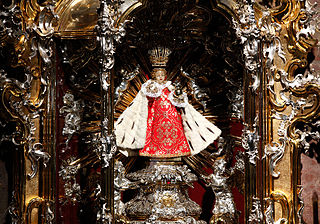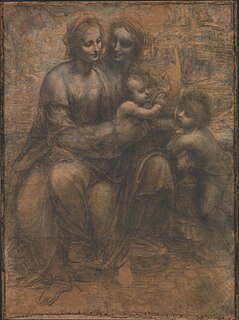
The Last Supper is a late 15th-century mural painting by Italian artist Leonardo da Vinci housed by the refectory of the Convent of Santa Maria delle Grazie in Milan, Italy. It is one of the western world's most recognizable paintings.

A Madonna is a representation of Mary, either alone or with her child Jesus. These images are central icons for both the Catholic and Orthodox churches. The word is from Italian ma donna, meaning 'my lady'. The Madonna and Child type is very prevalent in Christian iconography, divided into many traditional subtypes especially in Eastern Orthodox iconography, often known after the location of a notable icon of the type, such as the Theotokos of Vladimir, Agiosoritissa, Blachernitissa, etc., or descriptive of the depicted posture, as in Hodegetria, Eleusa, etc.

The Virgin of the Rocks is the name of two paintings by Leonardo da Vinci, of the same subject, and of a composition which is identical except for several significant details. The version generally considered the prime version, that is the earlier of the two, hangs in The Louvre in Paris and the other in the National Gallery, London. The paintings are both nearly 2 metres high and are painted in oils. Both were originally painted on wooden panel, but the Louvre version has been transferred to canvas.

The Christ Child, also known as Divine Infant, Baby Jesus, Infant Jesus, Child Jesus, the Holy Child, and Santo Niño, refers to Jesus Christ from his nativity to age 12.

The Adoration of the Magi is an early painting by Leonardo da Vinci. Leonardo was given the commission by the Augustinian monks of San Donato in Scopeto in Florence, but he departed for Milan the following year, leaving the painting unfinished. It has been in the Uffizi Gallery in Florence since 1670.

St. John the Baptist is a High Renaissance oil painting on walnut wood by Leonardo da Vinci. Probably completed from 1513 to 1516, it is believed to be his final painting. The original size of the painting was 69 x 57 cm. It is now exhibited at the Musée du Louvre in Paris, France.
The Madonna of the Yarnwinder is a subject depicted by Leonardo da Vinci in at least one, and perhaps two paintings begun in 1499 or later. Leonardo was recorded as being at work on one such picture in Florence in 1501 for Florimond Robertet, a secretary to King Louis XII of France. This may have been delivered to the French court in 1507, though scholars are divided on this point. The subject is known today from several versions of which two, called the Buccleuch Madonna and the Lansdowne Madonna, are thought to be partly by Leonardo's hand. The underdrawings of both paintings show similar experimental changes made to the composition, suggesting that both evolved concurrently in Leonardo's workshop.

The Madonna with the Long Neck, also known as Madonna and Child with Angels and St. Jerome, is an Italian Mannerist oil painting by Parmigianino, dating from c. 1535-1540 and depicting Madonna and Child with angels. The painting was begun in 1534 for the funerary chapel of Francesco Tagliaferri in Parma, but remained incomplete on Parmigianino's death in 1540. Ferdinando de' Medici, Grand Prince of Tuscany, purchased it in 1698 and it has been on display at the Uffizi since 1948.

The Aldobrandini Madonna is a painting from about 1509–1510 oil by the Italian renaissance artist Raphael. The picture is of the Virgin Mother, Christ child and infant John the Baptist, one of many paintings by Raphael with this trio. It is from early in his third, or Roman period, where distinctive changes are seen from his Umbrian or Florentine period in style, use of colour, and introduction of more natural subjects and settings.

The Holy Infants Embracing is a lost painting attributed to Leonardo da Vinci. It represents the infant Christ embracing his cousin John the Baptist. The subject matter relates to the two paintings of the Virgin of the Rocks by Leonardo and numerous other Renaissance works by Raphael and others of the meeting of the two children on the road to Egypt while escaping the Massacre of the Innocents.

The Madonna of the Carnation, a.k.a. Madonna with Vase or Madonna with Child, is a Renaissance oil painting by Leonardo da Vinci created around 1478-1480. It is permanently displayed at the Alte Pinakothek gallery in Munich, Germany.

The Virgin and Child with Saint Anne or Madonna and Child with Saint Anne is a subject in Christian art showing Saint Anne with her daughter, the Virgin Mary, and her grandson Jesus. This depiction has been popular in Germany and neighboring countries since the 14th century.

Gian Giacomo Caprotti da Oreno, better known as Salaì, was an Italian artist and pupil of Leonardo da Vinci from 1490 to 1518. Salaì entered Leonardo's household at the age of ten. He created paintings under the name of Andrea Salaì. He was described as one of Leonardo's students and lifelong servant and is thought by some to be the model for Leonardo's St. John the Baptist and Bacchus.

Salvator Mundi is a painting by the workshop of Italian artist Leonardo da Vinci, dated to c. 1500. The painting shows Jesus in Renaissance dress, making the sign of the cross with his right hand, while holding a transparent, non-refracting crystal orb in his left, signaling his role as Salvator Mundi and representing the 'celestial sphere' of the heavens. Around 20 other versions of the work are known, by students and followers of Leonardo. Preparatory chalk and ink drawings of the drapery by Leonardo are held in the British Royal Collection.

The Madonna and Child with the Infant St. John the Baptist is a lost composition by Leonardo da Vinci. The composition is known through a handful of paintings attributed to artists in Leonardo's circle. An original underdrawing by Leonardo may be preserved in a version in a private collection in Moscow, Russia.
Virgin and Child with Saint Anne is a subject in Christian art showing Saint Anne with her daughter, the Virgin Mary, and her grandson Jesus.



























